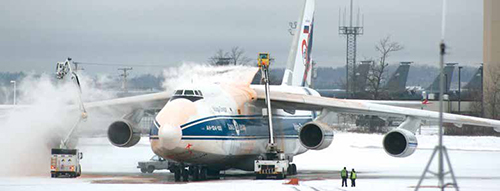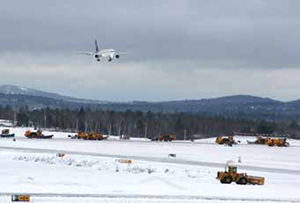How Bangor Int'l Stays Prepared for Unexpected Visitors

Thanks to its location in south-central Maine and an extra-long runway from its early days as a military base, Bangor International Airport (BGR) plays a critical and high profile role in the worldwide aviation network. Depending on the direction of travel, BGR is the first or last major U.S. airport for trans-Atlantic flights to make emergency stops.
Ever since airport officials started keeping track in 2005, nearly 1,200 flights have diverted to BGR to address fuel problems, wait out inclement weather and a variety of other reasons. On average, that amounts to almost 100 flights a year, or eight per month, for the city-owned airport.
Annually, BGR handles about 477,000 enplanements, with 12 to 20 flights per day, depending on the season.
| facts&figures Project: Accommodating Irregular Operations Location: Bangor (ME) Int'l Airport Annual Passengers: 477,000 Daily Scheduled Flights: 12-20, depending on the season Total Diversions Received: Nearly 1,200 since 2005 Avg. Diversions Per Year: About 100 Geographic Factor: Depending on direction of travel, Bangor Int'l is first or last major U.S. airport for trans-Atlantic flights needing to make emergency landings Reasons for Diversions (in order of volume): Fuel-related problems; inclement weather; medical emergencies; mechanical problems; security threats Financial Implications: Landing fees & other charges incurred during emergency landings range from $2,000-$5,000/diversion; airport uses revenue to help offset cost of providing emergency services Key Partners: TSA; Customs & Border Protection; FBI; airport food concessionaire; local law enforcement agencies & firefighting agencies; nearby hospitals; local bus company Joint Agreement: Air National Guard provides airport with aircraft rescue & firefighting service & equipment; BGR provides Guard with 24/7 ground services Key Resources: 11,440-foot runway; 4 international gates to handle international diversions & sudden passenger influxes; 3 fuel tanks with total capacity of 3 million gallons; airport-owned FBO; cross-trained & on-call employees |
"It's certainly not something we try to market, but we're here for any carrier that transits over the Atlantic Ocean," says Airport Director Tony Caruso. "Given our geographic location, we are the first major airport for flights coming into the United States and the last resort for outgoing flights on the Great Circle route. They can depend on us to handle their aircraft and passengers in a variety of situations."
BGR's role as the air system's safety net has grown throughout the years, he adds.
"I hate to say it's routine, but we do handle these kinds of flights regularly," observes Caruso. "It's all about teamwork with government agencies like the Transportation Security Administration, U.S. Customs and Border Protection, the FBI, local law enforcement agencies, the local fire department and the aircraft rescue and firefighting squad provided by the Bangor Air National Guard (which is based at BGR)."
From 2005 through 2016, the airport handled 1,191 emergency diversions: 709 for fuel-related issues, 254 because of bad weather, 95 for medical emergencies, 90 due to mechanical problems and 43 prompted by security threats.
One of the most memorable diversions occurred in May 2012, when a passenger aboard a US Airways flight from Paris to Charlotte, NC, announced that she was carrying a surgically implanted explosive device. "That, of course, was a major cause for concern-a very tense situation," Caruso relates. "In those cases, we play only a supportive role while law enforcement officials take the lead."
The airport's largest weather-related diversion occurred when a massive Nor'easter storm swept through the mid-Atlantic states on St. Patrick's Day in 2007, shutting down major airports in Boston, Philadelphia and New York City. "Our ramp was full of aircraft," Caruso recalls. "We hosted close to 1,000 passengers."
Over time, BGR has also developed a reputation within the industry as a go-to facility for technical stops. In addition, it still serves as a primary refueling hub for overseas military flights carrying personnel and cargo.
"We're really an aircraft pit stop-a gas station, if you will," Caruso says. "Whether it's corporate aircraft or international charter companies or domestic and foreign airlines, they all know they can rely on us and stop in Bangor for services."
At the Ready
BGR's military roots as a U.S. Air Force Base helped prepare the airport for its prominent role as a safe haven for stricken aircraft. Why? In order to accommodate B-52 bombers, military officials built an 11,440-foot runway. As such, BGR is equipped to handle today's biggest aircraft, including double-decked Airbus A380 wide-body jets and behemoth Antonov AN124 and AN225 cargo planes.
As such, the airport usually strives to keep about 1 million gallons of fuel on hand. "That's a lot for an airport our size, but we have the [storage] capacity because we used to be a military field," Caruso says. The airport has three fuel tanks: one that holds 2 million gallons and two others that hold 500,000 gallons each.
An extra-long runway and unusually large fuel reserves aren't the only factors that make BGR uniquely equipped for handling emergency landings. One is completely serendipitous: having two major hospitals within five miles of the airport. Other facilitating factors, however, are strictly by design. For instance, even though BGR doesn't offer any scheduled international departures, it has an international terminal with four gates. The terminal was built in 1974 for about $3.75 million and has been upgraded twice at a cost of roughly $15 million.
"The international gates are used only sporadically, but they're readily available for use at a moment's notice," says Caruso. While maintaining the largely unused terminal poses budgetary challenges, he considers such expenses a cost of doing business as the industry's "life preserver."

Landing and parking fees paid by diverted aircraft, plus associated fuel sales and ground handling revenue, help cover some of the costs of emergency services. Expenses vary according to aircraft size and the services needed, but usually range from $2,000 to $5,000 per operation, Caruso reports.
Local Resources
To offer a wide range of technical services and help entice airlines to use BGR as a hub, the airport owns and operates its own fixed-base operation (FBO). Financial support for the full-service facility comes from fees paid by airlines and other users.
"It's somewhat rare in the industry, although we're seeing more and more airports get into that realm," comments Caruso. "We're a one-stop shop for carriers...they fly the airplanes, and we take care of everything else. We do everything from ticketing and baggage handling to deicing and refueling aircraft.

"It saves the carriers money, because they don't have any initial start-up costs to hire personnel...they just contract with us for all their ground-handling," he continues. "We saw it as a strategic initiative to give carriers an incentive to come here."
The airport also benefits from a joint-use agreement with the local Air National Guard. Under the arrangement, BGR provides 24/7 operational services for the Guard; in return, the military unit provides the airport with aircraft rescue and firefighting support (equipment and personnel). "It's advantageous for both of us," Caruso explains. "We don't have to buy equipment, and they don't incur operational costs."
To further help it handle emergencies, BGR has established strong relationships with government agencies and local businesses. For example, Customs officers are available on short notice, and a standing agreement with a local bus company ensures that passengers on diverted flights have transportation to the terminal or local hotels.
Moreover, the airport concessionaire that provides in-flight catering also provides food for unexpected stranded passengers. "We have the ability to put the passengers in a large gatehold area that accommodates about 300 passengers," notes Caruso. "We can feed them there while they remain in a secure, sterile and comfortable location. And since we own and operate our own FBO, we can deploy resources faster to the right positions as needed...one radio call and we have everything in place in short order."
On-Call Staff
 To ensure that it can meet sudden and unexpected demands associated with emergency diversions, BGR keeps 12 to 20 employees on call at all times. In addition, the airport cross-trains many of its 70 full-time employees so they can assume various responsibilities as needed. For instance, airfield maintenance workers might also offload baggage, or aircraft technicians might also be qualified to deice planes. Typically, about 30 of BGR's full-time employees are dedicated to FBO operations.
To ensure that it can meet sudden and unexpected demands associated with emergency diversions, BGR keeps 12 to 20 employees on call at all times. In addition, the airport cross-trains many of its 70 full-time employees so they can assume various responsibilities as needed. For instance, airfield maintenance workers might also offload baggage, or aircraft technicians might also be qualified to deice planes. Typically, about 30 of BGR's full-time employees are dedicated to FBO operations.
"We aim for staff cross-utilization as much as possible," notes Caruso. "Sometimes it's all hands on deck, and our senior team and I take off our ties and do what's needed."
Over the years, BGR has developed a communications/chain-of-command notification system to use when emergency landings occur. "Sometimes diversions are very dynamic in nature, so we work hard to be sure everyone is on the same page at the same time," Caruso explains.
When the airport's 24-hour dispatch office receives an emergency notification from an aircraft pilot or FAA control tower, dispatch personnel use a text messaging system that simultaneously sends pertinent information to predetermined personnel at select agencies and entities. The list of people who receive text messages varies according to the type of emergency.
"Things happen quickly," Caruso relates. "For example, we've received calls about a sick passenger on an aircraft that's only 20 minutes out, and we'll have to get everything in place: crash/rescue teams, personnel to the lead aircraft to a parking spot, a medical team from one or both hospitals and Customs officers if it's an international flight."
To keep personnel prepared, the airport performs internal training exercises coordinated with its annual FAA emergency training. Additionally, airport managers meet once or twice a year to review a recent emergency diversion and evaluate staff performance. "We try to find out what we could've done better," Caruso explains. "We always like to think we're ready, but every situation is unique. That's one thing all parties understand.
"There's a routine nature to some of it. But since each operation is unique, it's important to always know what to do and be sure you're doing it when you should be doing it," he continues. "It's a collaborative and continuous effort...everyone here understands that we play a serious and important role and is very proud of what we do."
2022 Charlotte Douglas International Airport Report of Achievement
 Giving back to the community is central to what Charlotte Douglas International Airport and its operator, the City of Charlotte Aviation Department, is about, and last year was no different.
Giving back to the community is central to what Charlotte Douglas International Airport and its operator, the City of Charlotte Aviation Department, is about, and last year was no different.
Throughout 2022, while recovering from the COVID-19 pandemic, we continued our efforts to have a positive impact on the Charlotte community. Of particular note, we spent the year sharing stories of how Connections Don't Just Happen at the Terminal - from creating homeownership and employment opportunities to supporting economic growth through small-business development and offering outreach programs to help residents understand the Airport better.
This whitepaper highlights the construction projects, initiatives, programs and events that validate Charlotte Douglas as a premier airport.
Download the whitepaper: 2022 Charlotte Douglas International Airport Report of Achievement.








